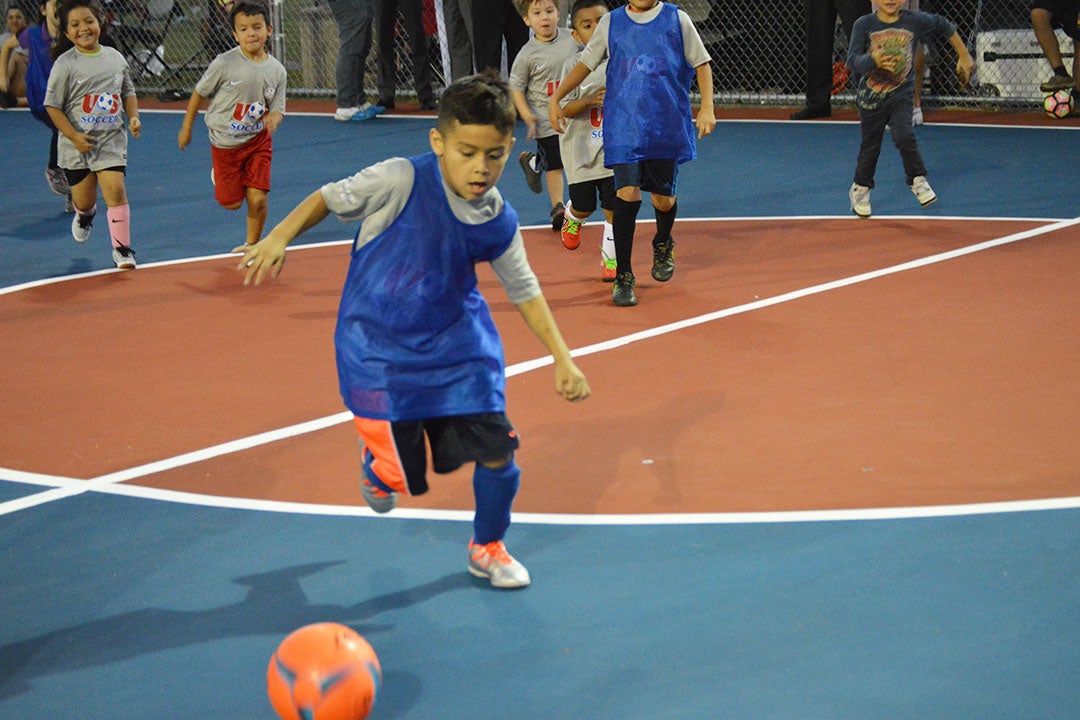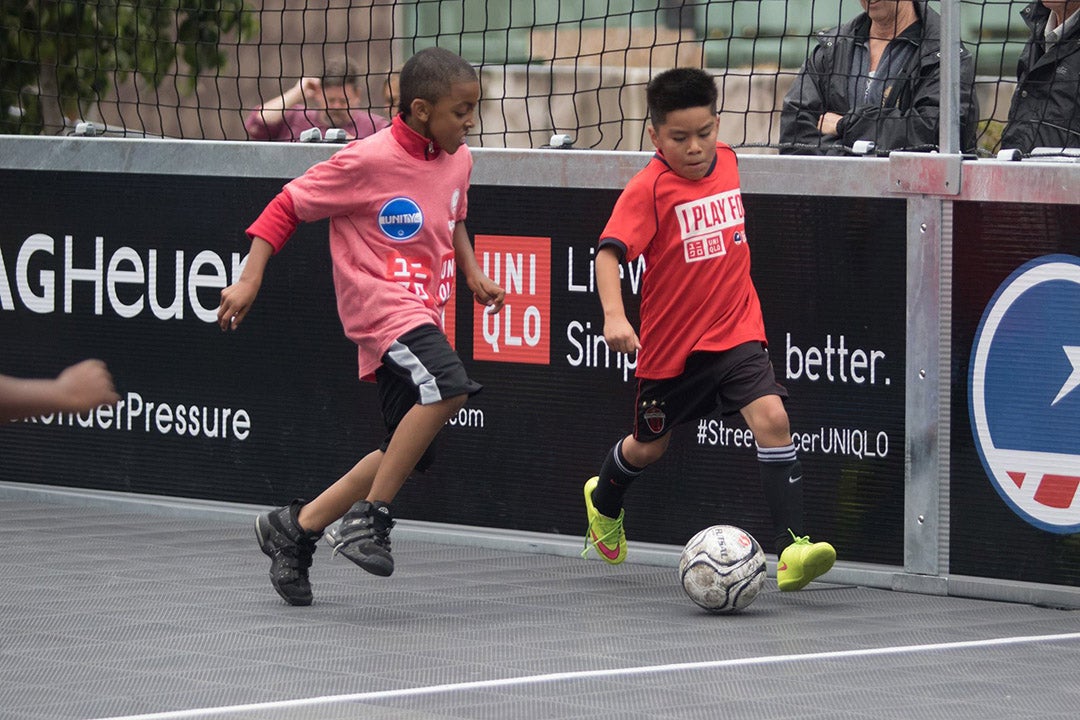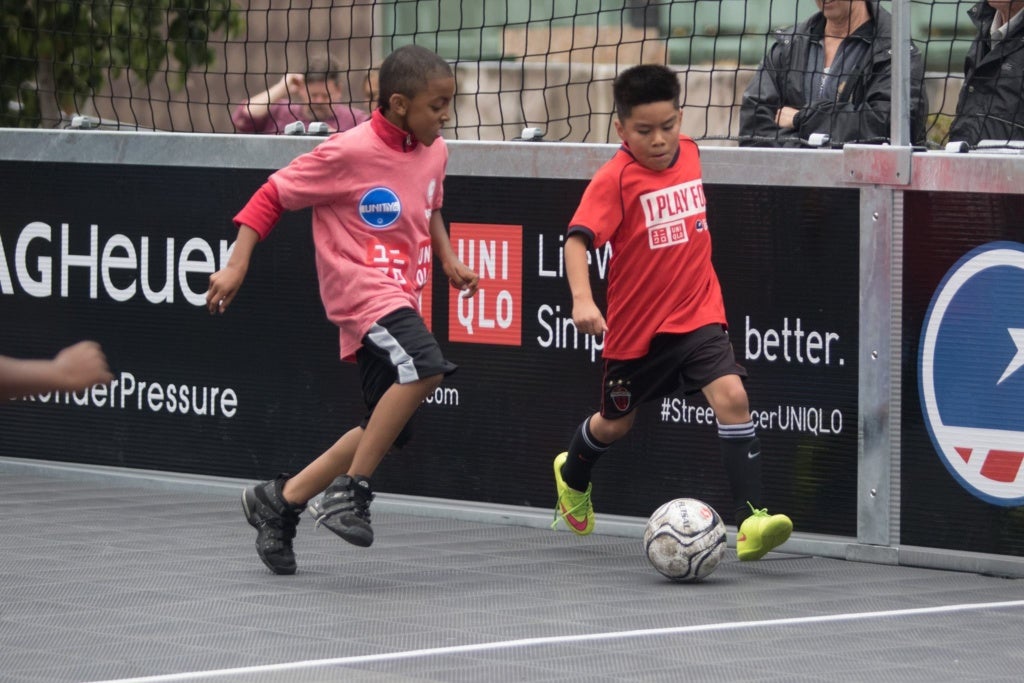
A lot of Latino talent is being missed in the US. Creativity and commitment are needed to provide more opportunities to Latinos in the pay-for-play US soccer model. (Photo courtesy of Street Soccer USA)
Johnny Martinez is playing college soccer this fall – and he’s doing so as a business major with an academic scholarship at Our Lady of the Lake University. He’s the first alum of the Urban Soccer Leadership Academy, which started in 2010 to help San Antonio urban youth play the game and advance to college.
More may be coming. Former San Antonio mayor Ed Garza, who founded USLA, said Martinez’s younger brother has visited several universities in Boston and wants to attend Duke for academics.
“These kids are now pushing us to make contacts and network across the country,” Garza said.
Or, to put it another way: “Stop wishing for it and start working for it,” Martinez said on his new team’s website when describing his favorite motto.
Yet Martinez is an outlier among Latino youth in American soccer. While Latinos below the age of 18 make up 25 percent of the US population within that age group, they comprise only 12.3 percent of male and 7.4 percent of female NCAA soccer players.
The gap speaks to the structure and culture of the game in the US at the youth level. In many countries around the world, soccer remains an egalitarian game that’s accessible to low-income populations. All a person needs are a ball and a space to play. In the US, youth soccer is a pay-to-play venture that has been dominated by the suburban middle class since the sport’s boom in the 1970s. It’s an environment where families may spend $5,000 a year for access to club teams and tournaments in the chase for a college scholarship.
It’s in this landscape where many Latino youth — whose culture is often identified by its passion for soccer — get left behind.
“There are more kids playing unorganized soccer in this country than organized soccer,” said Doug Andreassen, who recently served as chairman of the Diversity Task Force for the US Soccer Federation, the governing body for the sport. “We’re not even close to touching those kids. They would love to have US Soccer talk (about) them and say, ‘What’s the pathway for these kids if they don’t have $5,000 a year?’”
The average amount spent annually now by a US family with a child who plays soccer is $1,472, with some paying as much as $5,500, according to Utah State researchers. Their survey included families with children as young as 8 and who participate at all levels from recreational to elite.
To be clear, many underserved kids — not just Latinos — are forgotten. The focus in soccer often turns to Latinos because of their large population in the US and lower median household incomes — $45,148 compared to $62,950 for whites and $77,166 for Asians. Despite slowing population growth among Latinos, they still accounted for 54 percent of US growth between 2000 and 2014, according to a Pew Research Center analysis of US Census Bureau data.
As the barriers grow in gaining access to the club system that increasingly dominates the game’s landscape, national youth soccer participation rates for all ethnicities have declined. Just under 8 percent of kids ages 6-12 play soccer on a regular basis, according to the latest Sports & Fitness Industry Association sports participation survey. That’s down about 26 percent since 2011.
Track and field and wrestling are the only sports that experienced greater participation declines in that period. Baseball and basketball, the only two sports more popular than soccer, lost kids at a slower rate (about 11 percent each).
“There’s a lot of (Latino) talent being missed,” Garza said. “When I think about the colleges or pros not being able to tap into this huge market, it’s the same challenge with youth soccer clubs. Part of it is how to do it, and part of it is the commitment to do it.”
Beyond the economic barriers, grassroots soccer leaders like Garza identify a number of challenges in getting and keeping Latino youth in the game:
- Lack of safe, viable places to play in low-income communities
- Lack of transportation to practices and games
- Lack of trained youth coaches
- Too few Latino coaches trained in key competencies
- Administrative barriers – knowledge on how to organize a non-profit
- Language barriers – non-Spanish speaking coaches and administrators connecting with Latino kids and families
- Cultural barriers – merging Latino culture with the US suburban game
- Immigration concerns – fear of providing documents and information during the registration process that could be used against the family by government
“We know if they’re an immigrant family, we’re a little more sensitive,” Garza said. “We try not to keep any documents. For older teams that travel, especially close to the border checkpoint, parents are very reluctant to let their children go.”
Capturing more underserved Latinos isn’t simply about finding better talent for the pipeline that leads to the national teams, the primary focus of the US Soccer Federation. Grassroots innovators like Garza say they want to create healthier lives, pathways for college education, and more integrated communities.
In the US, 42 percent of Latinos are obese, compared to about a third of whites, according to the Racial and Ethnic Health Disparities report in 2016. The Hispanic high school dropout rate declined from 32 percent in 2000 to 12 percent in 2014, according to Pew. Yet just 15 percent of Hispanics have a bachelor’s degree or higher, trailing blacks (22 percent), whites (41 percent) and Asians (63 percent).
Some youth soccer organizers also understand the great impact the sport can have in empowering women in Latino communities. Experts say that due to their cultural upbringing, Latino females are often overlooked in sports participation. Since many parents may work long hours for little pay, females are usually asked to help support younger siblings or work a part-time job.
“We’re seeing more Latino girls who are interested in soccer,” said Diego Zegarra, development and special projects manager at the Park City (Utah) Community Foundation, which uses sports to integrate Latinos into the community. “But there’s still that stigma that soccer is a boy thing.”
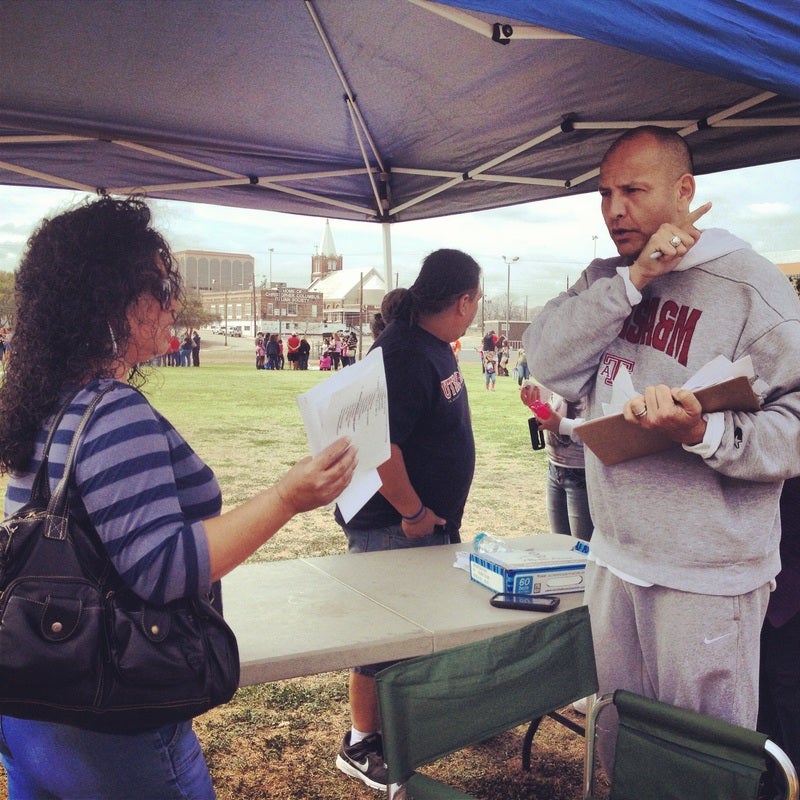
Former San Antonio mayor Ed Garza created the Urban Soccer Leadership Academy for underserved San Antonio youth. It’s a model some experts believe could work elsewhere in the country. (Photo courtesy of the Urban Soccer Leadership Academy)
Garza tries to keep a pulse on who’s bringing underserved Latinos into soccer — and he doesn’t see many soccer organizations trying.
“I understand why, given the challenges,” he said. “We’re a work in progress. The challenges are so significant that unless you have a committed group of leaders and volunteers to implement the vision, it becomes a daily challenge to get through a soccer season. You’ve got to be able to weather the storm of the initial few years to prove to people that you’re here to stay and it’s something to invest in.”
And that’s coming from one of the most successful innovators. Imagine the challenges other leaders face.
How does the American soccer model, tailored for higher-income families, adapt to the needs of Latinos with less money? How can leaders leverage the power and passion for a sport to improve the lives of Latino youth?
What is US Soccer’s role?
Andreassen doesn’t need to imagine the challenges. For a couple years, he was chairman of US Soccer’s Diversity Task Force. He was also president of Washington Youth Soccer, which oversees youth soccer in that state, for nine years.
At one point, Andreassen’s task force proposed that US Soccer create a national leadership academy. The goal would be to bring soccer to underserved youth and “empower leaders to launch, manage, play in and sustain community soccer programs,” according to a PowerPoint presentation Andreassen shared with the Aspen Institute’s Sports & Society Program.
The concept was that US Soccer, through sponsors and partnerships, would help underserved communities learn about topics such as partnership development, field rental, fundraising, and tax filings so they could enjoy similar opportunities as the wealthier, suburban leagues. The idea was to scale Garza’s model in San Antonio across the country, though Andreassen noted that a major challenge is different regions have different needs.
“We thought we had to educate community leaders, not soccer leaders, on the issue,” Andreassen said. “I put that together for the US Soccer board. It’s been before them about two years now. Nothing’s been done with it. That’s not a criticism of it. That’s just the way it is.”
Andreassen said the best word to describe the task force today is “dormant,” adding he’s not sure why. Another task force member, Ben Lear, confirmed the group no longer actively exists.
US Soccer’s website lists 16 committees and task forces; the Diversity Task Force is the only one without any contact names or information. “We are discussing the next steps for the Diversity Task Force,” US Soccer communications director Neil Buethe said in a statement.
“The question I always ask is if we as soccer fans in this country want the game to be the No. 3 sport (with fans behind basketball and football), where is the diversity?” Andreassen said. “When you call MLB or the NFL or US Tennis, or pick a sport, and make inquiries to talk to diversity officers, every sport will have one. You’ll see those sports are really dedicated to finding underserved youth. Call US Soccer for a diversity officer. Look at the website. There isn’t one.”
Tab Ramos, head coach of US Soccer’s under-20 men’s national team, said he has never heard of the US Soccer Diversity Task Force.
“We need to expand our talent identification department and make sure we scout where (Latinos) are,” Ramos said. “It doesn’t mean we need to change necessarily how someone who’s non-affiliated operates their leagues. I think we need to get out there and watch more players.”
Still, Ramos said that US Soccer is doing “a pretty good job now” at scouting emerging Latino talent and feels “fairly confident” that most of the promising youth players are being identified. The main way that the federation addresses the challenge, he said, is through its approximately 200 sanctioned clubs around the country that are charged with grooming talent for the national teams. US Development Academy clubs are in more than 40 markets — most of them large metropolitan areas — and offer scholarships for low-income players starting at the U-13 level.
Scholarships remove one barrier, though family challenges remain in the cost and time to transport players to regular, year-round training sessions at these clubs. US Soccer scouting director Tony Lepore said some federation club teams now use vans to transport youth.
“Because it’s not just tuition cost; it’s everyday cost,” Lepore said. “We’re a lot better off than we were 10 years ago. But I think it’s an ongoing issue and a big challenge, especially at the youngest levels, where it’s more of a business model than a player development model.”
According to Soccer America, 13 of the 21 players on Ramos’ US team at the 2013 under-20 World Cup were Hispanic. By 2015, however, the number of Hispanic players had dipped to six and “subtlety and artistry had been replaced by power and athleticism,” Soccer America wrote. Ramos said he looks for the best players, not specifically Latino players, so fluctuations in ethnic background are inevitable.
“Everybody wants to do better,” US Soccer president Sunil Gulati said about diversity in a 2016 article by The Guardian, adding that finding as many inner-city soccer players as possible is an important priority for US Soccer.
Much of the best work is being done by the US Soccer Foundation, which is affiliated with but not controlled by the federation. Created with surplus funds from the 1994 World Cup that was hosted in the US, the foundation has its own board and has made sport-based youth development in underserved communities its top priority. Working with cities, Major League Soccer clubs, philanthropies, and corporations, the foundation has transformed 84 mostly urban spaces into neighborhood mini-pitches, with another 221 fully funded projects in the pipeline, said Ed Foster-Simeon, CEO of the foundation. Among the groups that it has partnered with is Street Soccer USA, which brings soccer to homeless and underserved youth.
“The US Soccer Foundation’s Safe Places to Play program is focused on underserved communities and ensures play spaces are available to the community as a whole,” Foster-Simeon said. “The Foundation also ensures that priority is given to free after-school programs.”
In August, the foundation announced a partnership with Target to build 100 more mini-pitches by 2020, starting with three in Chicago. Target has committed $6 million to support the project. The foundation said it will work with each community to ensure each pitch offers free programming to youth and serves as a community hub.
The challenge is in creating pathways for youth to transition into sustainable, organized leagues, as well as the private clubs that dominate the pipeline that leads to college scholarships and elite opportunities. Structurally, major barriers to access remain in the US soccer system, especially when compared to the pipelines of other sports.
That was made evident in 2015 when journalist Roger Bennett and University of Chicago economics professor Greg Kaplan produced a study comparing the background of each US men’s soccer national team member from 1993 to 2014 with every NBA All-Star and NFL Pro Bowl player over the same period. Socio-economic data from the players’ hometown zip codes were compared. The study found the soccer players came from communities that had higher incomes, education and employment rankings, and were whiter than the US average. The NBA and NFL players came from communities that ranked lower than average on those same indicators.
For instance, the median household income for the hometowns of 2008-14 US men’s soccer players was $68,266, well above the US average ($52,762) and the hometowns of NBA All-Stars ($52,701) and NFL Pro Bowlers ($51,139). Household income for the communities of 2008-14 US Soccer players was down 6 percent from 1993-97, when soccer hometowns had an even greater gap with elite NFL and NBA players. Kaplan said via email that the study, first reported by The Guardian, was never published or widely disseminated.
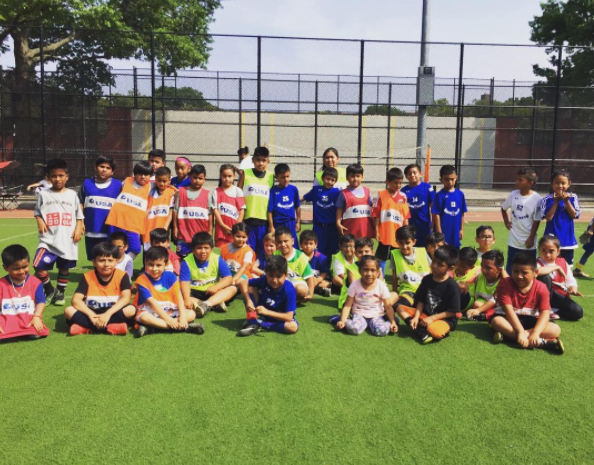
Street Soccer USA is finding smaller spaces for underserved youth to play soccer. About 45 percent of Street Soccer USA’s children are Hispanic. (Photo courtesy of Street Soccer USA)
“The ultimate approach that US Soccer and MLS is taking is pretty narrow,” said Lawrence Cann, CEO of Street Soccer USA. “It’s really not broad enough to encompass a lot of folks not on the radar screen. State associations are really the ones empowered to run soccer. I think it has to be a bottom-up build. US Soccer is always going to struggle from the top down to make a difference.”
‘If we ignore it, it’s going to compound the problem’
So, Latino soccer advocates develop solutions largely on their own. In Southern California, MaxInMotion director Hugo Salcedo organizes free coaching and player clinics and tournaments for 16 independent leagues. Most of the 25,000 youth are Hispanic.
Salcedo, who has served in executive positions with the US Soccer Federation, FIFA, and MLS, said he hasn’t received nor sought help from US Soccer.
“I don’t blame (US Soccer),” Salcedo said. “They’re so into what is theirs and they’ve never said to any of our leagues, ‘You don’t belong.’ (Dialogue) would be helpful for them to know, No. 1, we are not working against US Soccer, and second, for them to hopefully acknowledge independent leagues.”
Garza, the founder of USLA in San Antonio, increasingly gets invited to speak to federation state associations (he will also speak at the 2017 Project Play Summit on a panel devoted to exploring Latino soccer models). He has tried for years to help bring an MLS franchise to San Antonio in conjunction with widening the pool for Latino youth players to be seen.
“If we ignore it, it’s going to compound the problem,” Garza said. “I think MLS and US Soccer see there’s a bigger, untapped market there. That’s what we’re trying to highlight – that it’s really a business investment for MLS to serve this underserved market.”
Twenty-nine percent of Hispanic millennials surveyed in 2014 indicated they had played soccer in the past 12 months, according to a report by sports agency Octagon. That was 232 percent higher than the average US population, Forbes reported.
Hispanic interest in soccer isn’t translating into the coaching ranks. Only five of the 22 MLS head coaches are minorities — one more than there was in 1998. That’s despite MLS requiring teams since 2007 to interview minority candidates for head coaches, assistant coaches, youth coaches, and technical directors.
FC Dallas Academy director Luchi Gonzalez said MLS teams have a duty to help build up Latino players and coaches. For years, Gonzalez said, MLS teams have competed against youth academies in their market to attract the best player talent.
“I think we’re growing out of that and we know we’re the only professional club in Dallas, so it’s a reality for our boys to be a pro, not a dream,” Gonzalez said. “The next step is now to give back and maybe be more connected to the community in coaching education. Maybe it takes pro clubs partnering with smaller recreational programs and helping with curriculum.”
Affiliates of US Soccer are aware of the need. US Youth Soccer, the largest youth soccer organization in the country, has a program called Soccer Across America (formerly known as Soccer Start), which introduces the game to communities not yet served by existing clubs and leagues. It’s focused on lower-income children.
“To grow participation, we need to take the game to areas that otherwise wouldn’t have a safe place to play,” said US Youth Soccer CEO Chris Moore.
Where soccer fields are created, municipalities need to make sure equity inclusion commitments are made to ensure that underserved kids indeed gain access to them, Andreassen said. Many Latinos come from areas where a patch of grass or any open space means you freely play soccer. In the US, that grass is often used by leagues with the money and know-how to get permits. Sometimes, disagreements over field access results in police being called, leaving Latino players to migrate from one field to another, Andreassen said.
Garza doesn’t think MLS and US Soccer can come up with answers. Rather, he believes it’s up to local communities to put the pieces in place with local government and partnerships that creates models that, in turn, generate a response and deeper support from the federation as well as MLS.
The Aspen Institute identified four organizations — big and small; East Coast, West Coast and Southwest — that offer promising examples of how to serve youth in Latino communities. These are their stories.
